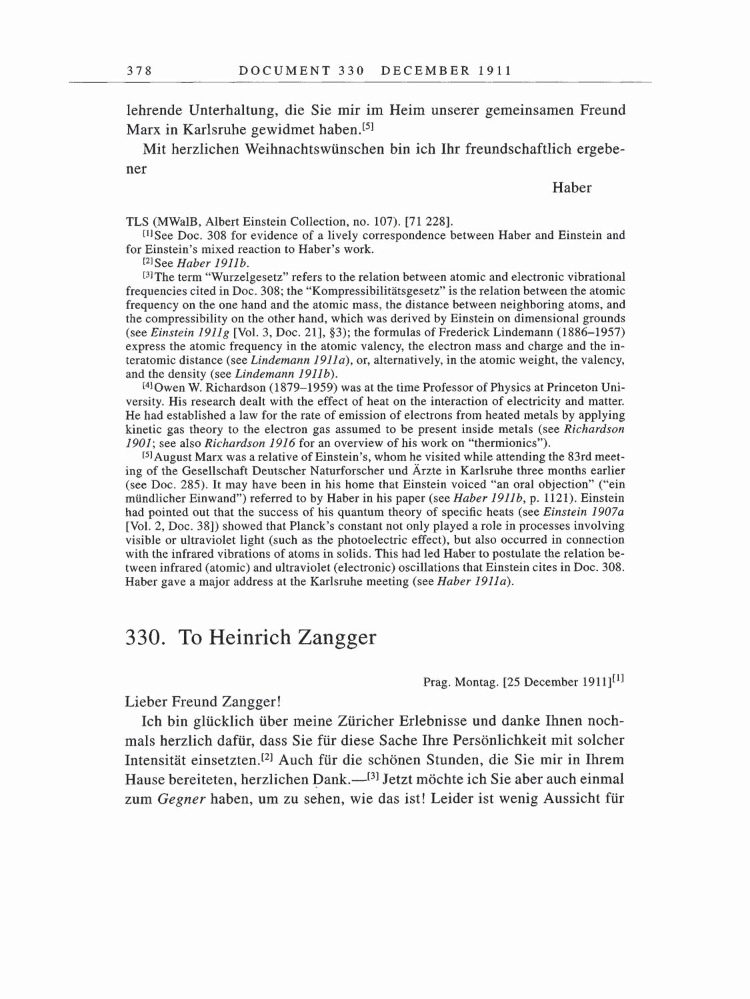378 DOCUMENT 330 DECEMBER 1911 lehrende Unterhaltung, die Sie mir im Heim unserer gemeinsamen Freund Marx in Karlsruhe gewidmet haben.[5] Mit herzlichen Weihnachtswünschen bin ich Ihr freundschaftlich ergebe- ner Haber TLS (MWalB, Albert Einstein Collection, no. 107). [71 228]. [1]See Doc. 308 for evidence of a lively correspondence between Haber and Einstein and for Einstein's mixed reaction to Haber's work. [2]See Haber 1911b. [3]The term "Wurzelgesetz" refers to the relation between atomic and electronic vibrational frequencies cited in Doc. 308 the "Kompressibilitätsgesetz" is the relation between the atomic frequency on the one hand and the atomic mass, the distance between neighboring atoms, and the compressibility on the other hand, which was derived by Einstein on dimensional grounds (see Einstein 1911 g [Vol. 3, Doc. 21], §3) the formulas of Frederick Lindemann (1886-1957) express the atomic frequency in the atomic valency, the electron mass and charge and the in- teratomic distance (see Lindemann 1911a), or, alternatively, in the atomic weight, the valency, and the density (see Lindemann 1911b). [4]Owen W. Richardson (1879-1959) was at the time Professor of Physics at Princeton Uni- versity. His research dealt with the effect of heat on the interaction of electricity and matter. He had established a law for the rate of emission of electrons from heated metals by applying kinetic gas theory to the electron gas assumed to be present inside metals (see Richardson 1901 see also Richardson 1916 for an overview of his work on "thermionics"). [5]August Marx was a relative of Einstein's, whom he visited while attending the 83rd meet- ing of the Gesellschaft Deutscher Naturforscher und Ärzte in Karlsruhe three months earlier (see Doc. 285). It may have been in his home that Einstein voiced "an oral objection" ("ein mündlicher Einwand") referred to by Haber in his paper (see Haber 1911b, p. 1121). Einstein had pointed out that the success of his quantum theory of specific heats (see Einstein 1907a [Vol. 2, Doc. 38]) showed that Planck's constant not only played a role in processes involving visible or ultraviolet light (such as the photoelectric effect), but also occurred in connection with the infrared vibrations of atoms in solids. This had led Haber to postulate the relation be- tween infrared (atomic) and ultraviolet (electronic) oscillations that Einstein cites in Doc. 308. Haber gave a major address at the Karlsruhe meeting (see Haber 1911a). 330. To Heinrich Zangger Prag. Montag. [25 December 1911][1] Lieber Freund Zangger! Ich bin glücklich über meine Züricher Erlebnisse und danke Ihnen noch- mals herzlich dafür, dass Sie für diese Sache Ihre Persönlichkeit mit solcher Intensität einsetzten.[2] Auch für die schönen Stunden, die Sie mir in Ihrem Hause bereiteten, herzlichen Dank.-[3] Jetzt möchte ich Sie aber auch einmal zum Gegner haben, um zu sehen, wie das ist! Leider ist wenig Aussicht für
